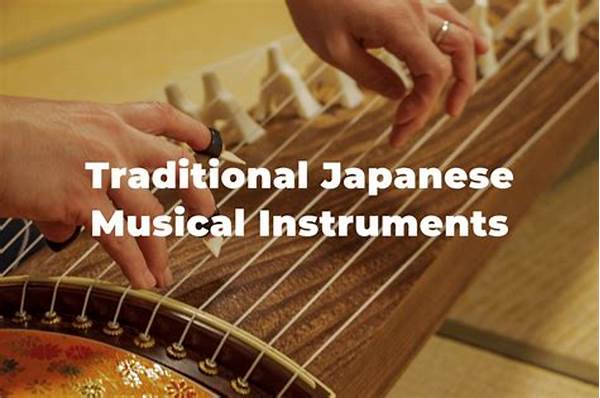In the ever-evolving world of music, there’s a magical bridge that connects the sounds of yesterday with the rhythm of today. That bridge is the harmonious integration of traditional Japanese instruments into contemporary music scenes. This isn’t just about keeping ancient sounds alive; it’s about reinvigorating them, reimagining them, and watching them soar on new wings. Picture this: the ethereal sound of the koto blending perfectly with a modern synth. Intriguing, right? You’re not just listening to a mix of instruments; you’re stepping into a new age of musical fusion. Traditional Japanese instruments integration is not just a trend but a revolutionary movement. Jump on board, and let’s explore how these ancient sounds can redefine the music we know!
Read Now : Merengue Music Global Influence
Bringing Heritage to the Modern Hits
Imagine walking into a concert where the ancient, soulful hum of the shakuhachi flute marries seamlessly with a thumping bassline. This is the power of traditional Japanese instruments integration; it’s about honoring the past while grooving into the future. Seriously, you can feel the vibe shift in the room when those traditional notes hit. The raw emotion and rich history carried by each string and breath transform the soundscape. It’s like a nostalgia trip and a futuristic journey wrapped into one mesmerizing experience. People are catching the wave, and mainstream hits are getting a flavor boost thanks to traditional Japanese instruments integration. It’s not just a blend; it’s an evolution. Trust me; you don’t want to miss out on this epic sound sensation that brings the past into the present with a bang!
Why Traditional Japanese Instruments Keep it Real
1. They’ve Got Soul, Dude! – Traditional Japanese instruments integration brings that raw, authentic vibe that hits you right in the feels.
2. No Copycats Here! – The unique sound of these instruments means your track stands out from the noise when you use them in traditional Japanese instruments integration.
3. Vibe with the Legends – Using traditional Japanese instruments lets you tap into a deep well of musical history. That’s some epic energy right there!
4. Mix it Up! – Perfect for blending genres, traditional Japanese instruments integration takes your music from basic to bold real quick.
5. Trendsetters Unite – This integration is the hot ticket right now in the music world. Join the coolest club with traditional Japanese instruments integration!
Spicing Up the Sounds of Tomorrow
You ever catch a tune that makes your ears perk up like a puppy hearing the word “walk”? That’s what traditional Japanese instruments integration does, my friend! Picture this: a DJ blending the beats with a taiko drum, sending ripples of epicness through the crowd. It’s all about fusing those ancient vibes with today’s hits, creating a sound that’s both a blast from the past and a sneak peek into the future. People dig it because it’s something fresh. Traditional Japanese instruments integration isn’t just about playing old instruments; it’s about energizing them with new vision and creativity. So, if you’re down for a sonorous adventure, this is the train you wanna catch!
Read Now : Discovering New Chart Hits
The Magic of Old meets New
Let’s drop some truth bombs, shall we? Traditional Japanese instruments integration is like that secret ingredient that makes a dish absolutely pop. You got your regular, dope tracks, and then WHAM! Throw in the whispers of a bamboo flute or the strong beats of a traditional drum, and you’re cooking up an audio smoothie that’s got everyone like, “Say what?” It’s about layering textures and creating soundscapes where old-school meets new school in a super juicy jam. Musicians are literally sculpting the future of sounds and taking fans on audio trips that are nothing short of legendary. Traditional Japanese instruments integration is flipping the script, and honestly? We’re all here for it.
Mixing the Old with the New Beats
Modern Tracks with a Touch of Tradition
The new wave in music is all about diving into the good old days while surfing the crest of today’s beats. That’s where traditional Japanese instruments integration comes in, folks. It’s like mixing the comfort of grandma’s cooking with that spicy new takeout joint everyone’s tweeting about. Musicians are digging into history to pull these sounds from the past, crafting tunes that echo with the heart and soul of ancient Japan. It’s not just about playing an instrument; it’s about telling a story, passing down vibes across generations, and cranking up the volume on what’s possible in music.
Old-School Flavors in New-Age Tunes
When it comes to jamming out with traditional Japanese instruments integration, it’s all about riding the waves of creativity. Picture this: twangy koto strings mingling with hip hop beats or the shakuhachi’s breathy notes lacing an EDM track with intrigue. This isn’t your run-of-the-mill mashup—it’s an artist’s playground. Whether you’re a musician or just a passionate listener, the combo of traditional and modern elements paints a vivid picture, an audio kaleidoscope that’s seriously lit. Trends may come and go, but epic sounds shaped by traditional Japanese instruments integration? Those are the jams that stick around, forever fresh and constantly evolving.
Blending Cultures, Amplifying Sounds
In this mix-and-match world, one thing’s for sure: the more diverse the sound, the richer the experience. Traditional Japanese instruments integration is redefining how we groove to music. Bringing together the authenticity of traditional instruments with modern beats creates layers upon layers of sound. It’s like adding extra whipped cream to your sonic latte. Traditional songs are injected with fresh energy, and contemporary hits get a timeless twist. This mixing isn’t just ear candy—it’s cultural homage, musical fusion, and a bridge connecting the past to the future. And who doesn’t love a chance to groove to something that speaks to the soul? The beat just got hotter, my friend.
